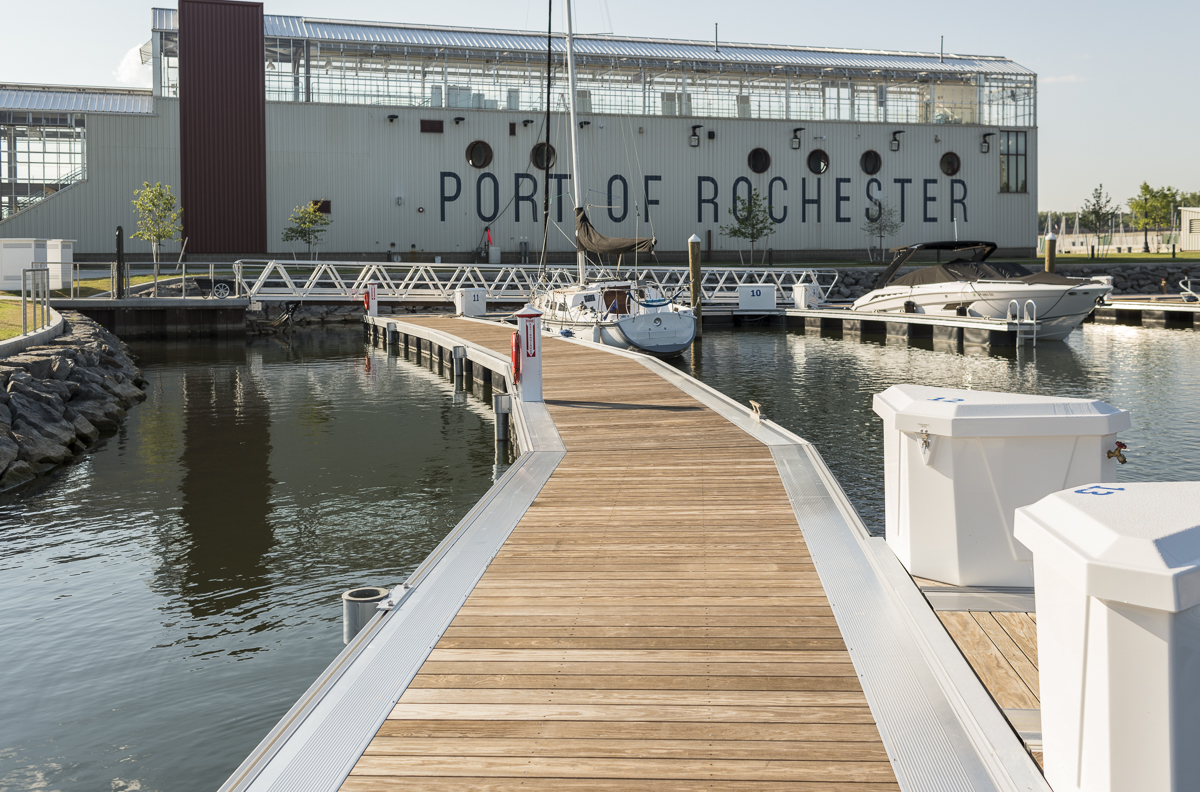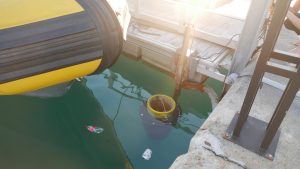
Sustainable Design Strategies and Cost Savings
Published on November 12, 2020Designing for sustainability is too often mistakenly associated with higher costs, but there are in fact many ways in which incorporating sustainable design strategies can save money on initial construction, long term maintenance, and yearly operational expenses.
Design and Renovation
While we don’t build a completely new marina as often as we renovate existing facilities, many sustainable design strategies apply in both situations. Sustainable design begins with maximizing the efficiency of the facility while minimizing the volume of materials needed to build and protect it. For new facilities, site selection is potentially the most important factor in long term sustainability, followed closely by the proper layout of the facility on the site.
The most sustainable facilities are located where the need for wave protection and attenuation are lowest, and access to necessary utility infrastructure is closest. For locations along the open coast of a Great Lake, or within large bodies of water open to a long fetch or incoming ocean waves, an excavated interior basin marina with a properly designed entry can be more cost effective and need less protection than an offshore facility that requires a large breakwater. Such a breakwater may necessitate mining and transporting huge amounts of armor stone which can impact bottomlands.
If an offshore facility is the only path forward, then the layout and orientation of the docks within the facility becomes critically important. Since the wave size that boaters can comfortably tolerate on the bow or stern is approximately twice as high as the wave they can comfortably take on the beam, orienting the docks perpendicular to the incoming waves in a new or renovated facility can greatly reduce the amount of armoring and wave attenuation needed, thereby greatly reducing costs. There are many other considerations with similar effects, including engineering structures to redirect sediments away from navigable areas and towards areas where the sediments can help create habitat features.
When considering utilities, Wi-Fi at the slip has become a nearly essential amenity in modern marinas and has all but replaced hardwired communication in most new marina construction. Eliminating costly wiring runs for telecom and cable TV saves money and greatly reduces the quantity of materials used in the facility. Engaging a highly qualified marina electrical engineer can also result in big savings and reduced material use. They may be abile to utilize 480 three phase power and step-down transformers to reduce the amount of wire and copper needed. Both of these strategies also reduce long-term maintenance since wire that is not installed cannot wear or fail, and never needs to be replaced.
Long-Term Maintenance
Materials selection is one of the most important elements when considering sustainability and long-term maintenance — life cycle costing is very important. Wood decking material options, for example, range widely in cost and environmental impact. At the lowest initial cost is traditional treated pine, which due in part to less effective but more environmentally sensitive treatments, are less durable now than in the past. With an effective lifespan of 10-15 years, marinas can expect to replace the boards once or twice over the 30-year lifespan of a floating dock – doubling or tripling the life cycle cost, not counting yearly board replacement labor and the nuisance of trip hazards.
Choose ipe on the other hand, a very expensive but super durable tropical hardwood, and marinas can expect a 30 year lifespan but at the cost of extracting hardwoods from sensitive rainforest environments. Kebony, on the other hand, is a modified pine product that utilizes a byproduct of the sugar industry to stabilize the cellular structure of the wood. The result is a real wood product with no chemical additives that looks and lasts over 30 years much like ipe, but at a much lower cost and does not impact rainforests. Considering life cycle costs, including reduced maintenance, a product like Kebony can be more attractive, durable, and less costly than traditional pine.
Operational Expenses
Reducing yearly operational expenses through implementation of sustainability strategies is a win for the marina owner and the environment. As more and more electronic devices are added to boats, shore power demand continues to increase. Marinas can minimize the use of energy in harbor facilities through the use of LED lighting fixtures and Energy Star rated appliances wherever practical. Incorporate Dark Sky lighting strategies that aim to minimize light pollution and glare. The strategy is to use efficient light fixtures with shielded cut-off lenses, and strategically place light only in areas that need to be lit. Dark Sky lighting can help people see better at night, attract fewer insects, and reduce light pollution that can negatively impact migratory birds.
When designing or renovating buildings, incorporate natural daylighting strategies to reduce the need for artificial lighting, and install motion activated and dimmer switches to reduce energy use. Alternative energy sources such as solar, wind, and geothermal should be explored. Consider installing low flow and high-efficiency fixtures for all restroom plumbing, washroom facilities, showers, and laundry facilities.
When upgrading marina pedestals, select equipment with built-in individual metering. This has been proven to reduce energy usage by over 30%, which translates directly to the marina’s bottom line. Better yet, charge slip holders for the energy they use, and let them decide how much energy they need. This could likely reduce energy usage even more. Also factor in the electrical demand requirements of ice suppression systems when selecting between fixed or floating dock systems.

Other elements to consider would be the installation of Seabins to keep marinas clean and free of trash, both improving water quality and reducing maintenance time. It is much easier for staff to remove trash from a single location in the water rather than walking the facility with a skimmer for hours on end, and of course the boaters (and the birds and fish) all appreciate clean water! Where practical, harbor facilities should incorporate natural shoreline protection strategies and implement Low Impact Development (LID) stormwater strategies to manage stormwater on site and minimize negative impacts to water quality. This is particularly important in facilities with launch ramps and/or haul out wells, where hull wash down activities are performed.
All facilities that perform pressure washing on hulls should have a wash down collection system to prevent wastewater from entering the waterbody. Management strategies to minimize the spread of Aquatic Invasive Species should be incorporated into all facilities, as well as the design guidelines and standards outlined in the Clean Marina program.
Future Trends
Two major trends that were widely discussed at the last International Council of Marine Industry Associations (ICOMIA) World Marinas Conference were the rapid increase in boat sharing and the future electrification of boating.
Boat clubs and boat sharing programs are becoming more popular and are a very exciting way to introduce newer and younger families to boating.
Organizations that rent boats to the general public or to club members allow many more boaters to access the water at a much lower cost, while using far fewer boats. An average seasonal renter may take their boat out once or twice per week, while a boat club vessel will likely leave the slip five or six days of the week, and often multiple times per day on weekends and holidays. As these are commercial businesses that utilize marina facilities, as well as adding a significantly higher demand for parking and harbor amenities, it is reasonable to charge significantly more for the slip rental than to a typical private boater, generating more revenue per slip for the marina. At the same time, clubs and rentals create more access for more people with lower environmental impact. The revenue potential of renting boats and paddlecraft directly to the public can in some cases exceed the slip rental revenues in some public marina facilities.
While not currently a significant factor here in the United States, the European boating market is experiencing the beginning of the electrification of powerboats. When that trend inevitably reaches the US market, the impact will more likely be felt on fuel sales rather than electrical infrastructure, as existing marine systems are reasonably well suited to battery charging. Just as Tesla is transforming the traditional car market, the boating world is ripe for transition to a cleaner, quieter, and more sustainable energy source. Fortunately, our existing shore power infrastructure is very well suited to this type of charging demand.
Summary
In summary, integrating sustainable design strategies has both environmental and economic benefits. Similar to switching over to an electric vehicle from a traditional internal combustion engine, some of these strategies may seem cumbersome, and all of them require some level of investment in new technologies such as a vehicle charger. However, the life cycle costs of an electric vehicle are half the cost of a traditional car, and drivers quickly get used to charging rather than filling up at the pump. Marina staff and boaters will also quickly adapt to the new approach, and the long-term savings will improve long term operation efficiency while reducing our impact on our environment.
| Categories | |
| Tags |





